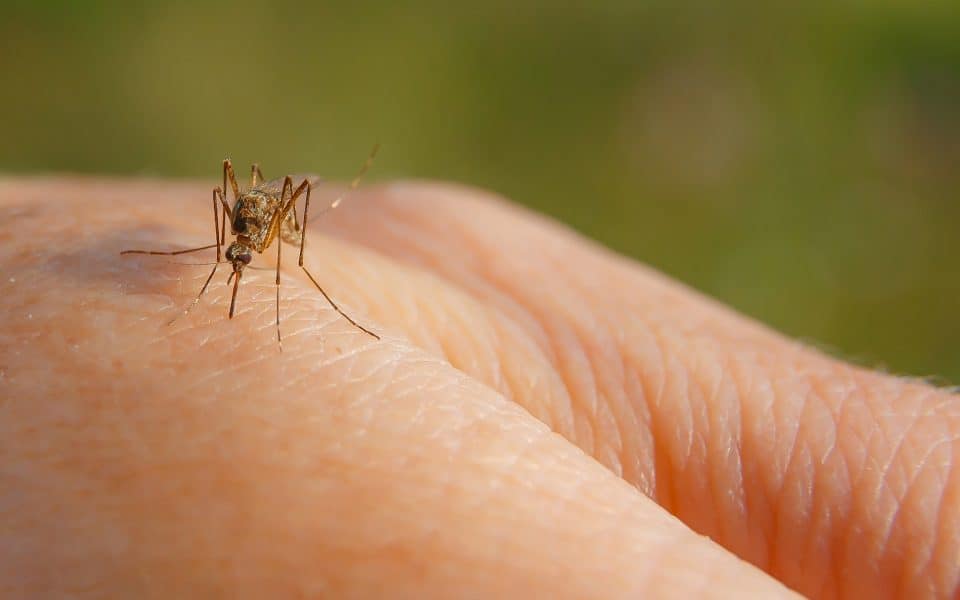The outdoors is filled with flying, creeping, crawling pests. Some, like blackflies, mosquitoes and ticks are expected. Others, like hornets, wasps and spiders often take us by surprise. All can be dealt with to one degree or another. Let’s take a look at the more common six- and eight-legged pests we could encounter, the dangers they pose and tips on protecting yourself from insect bites and stings.
Mosquitoes
Mosquitoes suck! Though we call it a bite, they actually sting, piercing the skin with a modified proboscis. Only females “bite,” and they do so to suck up the blood meal necessary to produce eggs. When they do, they also inject saliva, which our bodies react to by producing an itchy welt. It is annoying but relatively harmless. However, mosquitoes can also transmit diseases like West Nile virus and eastern equine encephalitis, which can be potentially fatal to humans.
Their level of annoyance can vary from that persistent little individual that whines around your ears on an early fall bow hunt to clouds that assault relentlessly on a spring turkey or bear hunt. They’re widespread throughout North America but particularly abundant and annoying in northern states like Maine, Minnesota and Alaska, the latter of which facetiously claims the mosquito as its state bird.
The traditional preventative was, and still is liquid repellents, usually containing DEET (N,N-diethyl-meta-toluamide). The U.S. EPA has “not identified any risks of concern to human health, non-target species or the environment,” related to DEET. It works by confusing and interfering with the receptors on a mosquito’s antennae, which they use to detect body heat, carbon dioxide and skin chemicals. The pro is: it works, but there are a couple cons. One is odor; DEET-based repellents have a distinct chemical odor, which keen-nosed game like deer and bears can detect. Another is longevity. Over time, the chemicals vaporize and become less effective, a process accelerated by sweating, which we do more of in the warm temperatures that mosquitoes prefer.
Recent years have seen an increase in organic repellents that use plant-based oils. They too work and they smell. However, as the aroma is natural and plant based, it is less likely to alarm game. I say, “less likely” because even natural odors may be foreign in a particular location. Most are sprayed or wiped on, but one uses a unique approach.
The ThermaCell uses a small butane-fueled heating element to warm a felt pad saturated with a synthetic chemical that very closely resembles the aroma of geraniums. No, geraniums don’t grow everywhere, but after using a ThermaCell on dozens of deer and bear hunts all over North America, I’ve never noticed a negative reaction to its aroma. Furthermore, it works very well at repelling mosquitoes.
There are physical options as well including head nets and bug suits. The pro is that they provide a nearly impenetrable physical barrier, provided they’re worn properly. As with chemical, there are cons, including comfort, or lack thereof. Some folks don’t mind them but I find it harder to breath and more importantly, see through.
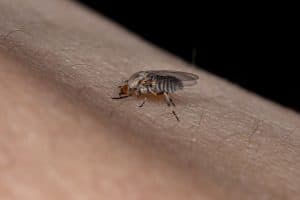
Vinicious R. Souza
Blackflies
Also called buffalo gnats or white socks, these members of the Simuliidaeare family are a bit less delicate. They most definitely bite, using tiny mouth parts to grasp and spread your skin then slice through it with their jaws. The result is also itchy welt, and the bite may draw blood as well, which only attracts more of their bothersome brethren.
Their abundance tends to be more confined, usually starting around the first consistent stretch of warm weather and tapering off after several weeks. But when they come, they come in droves. Even without the bites they can be quite annoying, swarming around your head and flying into every exposed orifice or crevice including nose, ears, mouth and eyes. You can tell when the fishing was good because you come out of the woods covered in blood and welts. The blackfly can transmit a parasitic nematode that causes river blindness. However, about the closest it gets is southern Mexico.
When I moved to Maine – blackfly world headquarters – I was introduced to something called Ole Time Woodsman Fly Dope. This pungent dark brown liquid is made from pine tar, petroleum distillates like mineral oil and other secret ingredients designed to deter blackflies and as its manufacturers claim, “mask the natural odor of a ripe lumberjack.” It works in both ways, and may even repel ripe lumberjacks, keen-nosed game and most people who don’t spend much time outdoors, which may not be so bad. Fortunately, most of the same repellents you use for mosquitoes also work on blackflies, without being quite so “aromatic.”
Ticks
Like the aforementioned, female ticks bite to get a blood meal. However, males and even larval ticks also bite. While we tend to lump hundreds of species of mosquitoes and blackflies into their respective groups, there are some distinct differences between tick species, so we’ll look at a few of the more common and nefarious culprits.
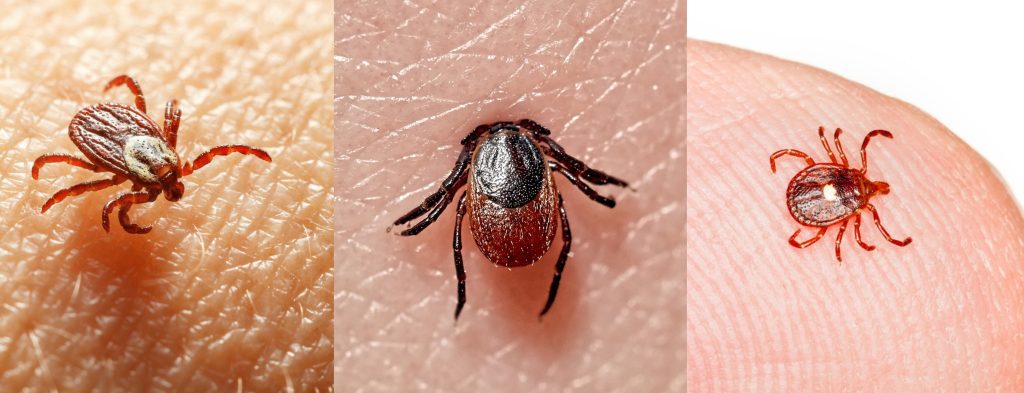
Anest Evgeniyqw & Steve Heap
The American dog tick (Dermacentor variabilis), known as a “wood tick” is widely distributed east of the Rockies while its close cousin D. similis fills the same niche west of the Rockies. The most common result of a tick bite is a similar itchy welt that often persists longer than an insect bite. However, these species can transmit tularemia and Rocky Mountain spotted fever.
The “blacklegged” or deer tick (Ixodes scapularis) is also widely distributed across the eastern U.S., and can transmit a virtual who’s who of diseases or disease-causing agents including Lyme disease, anaplasmosis, ehrlichiosis, babesiosis and Powassan virus.
Public enemy Number 1 on the Most Unwanted list might be the lone star tick (Amblyomma americanum). Widely distributed in the east, but most common in the south, its bite can cause human ehrlichiosis, tularemia, Heartland virus disease, Bourbon virus disease, southern tick-associated rash illness (STARI) and alpha-gal syndrome (AGS) (see sidebar).
Another difference is that upon biting, ticks hang on for as long as they can while engorging themselves with blood, and transmitting saliva, bacteria and other potentially harmful substances. The best treatment is preventative. That starts with a tight-fitting base layer, followed by cinching up clothes, especially around sleeves and pant legs.
Next comes chemical repellents. DEET does repel ticks but again, has an odor and a relatively short period of effectiveness. A more effective and long-lasting solution is to apply permethrin (a chemical sold under several different trade names) to your clothing. Spray it on. Let your clothes dry and the permethrin will act as an effective insecticide for several weeks.
Even with the best repellents you may still find ticks lodged in your skin. According to the experts, most of the aforementioned diseases are not transmitted if you remove the tick within 24 hours of attachment, and how you remove them is important (See Sidebar). Check yourself every day after leaving the field.
Recognizing whether you’ve been infected can be very difficult and diagnosis is best left to a physician. Things to look for include a rash – especially the so-called bulls-eye rash – signs of infection such as redness, warmth swelling and pain, or symptoms like fever, headache, fatigue, chills, stiff neck muscles or joint aches. Regardless, when in doubt, see a doctor; and save the tick if you can.
Chigger Bites
Chiggers (Trombicula sp.) also referred to as harvest mites, berry bugs, red bugs and a host of other un-repeatable names, are nearly microscopic mites. Shortly after hatching, tiny chigger larvae climb up onto vegetation where they lie in wait for a passing host. Once aboard, they insert their mouthparts in a skin pore or hair follicle and inject a salivary secretion containing powerful, digestive enzymes to liquefy the skin cells they feed on. They often “attack” en masse leaving the victim with small, reddish welts accompanied by intense itching.
Preventative action is much the same as for ticks, wear tight clothes and apply DEET repellent or treat clothes with permethrin. There are all sorts of remedies for temporary relief ranging from the somewhat reliable (ointments of benzocaine, hydrocortisone, calamine lotion and After Bite) to the somewhat outlandish (Vaseline, cold cream, baby oil, fingernail polish and Listerine).
Hornets, Wasps and Bees
Due to several similarities we’ll lump this set of stingers into one group. Unlike all of the above, they don’t seek us out for an easy meal. Avoidance is often enough, but we still occasionally intersect these insect’s path and incite an angry response.
The all have stingers in their abdomen that they use largely as a defense mechanism, both stabbing, and injecting venom. Hornets and wasps can sting multiple times so you’ll want to dispatch the offending insect by the quickest, most effective means possible. Pain can be quite intense, though physical damage and complications are usually minimal. Honeybees only get one shot, sacrificing their lives in the process. Unlike wasps, the bee’s stinger is barbed so it lodges in its victim’s skin. The bee then pulls away leaving its stinger behind with a small attached sac that continues pumping venom. It also releases a pheromone that incites other bees to attack. If stung, remove the stinger as quickly as possible with a knife blade, credit card or other flat object, being careful not to squeeze the sac.
You may not find it in the medical journals, but I’ve found applying diluted ammonia to a sting will reduce pain and swelling. Other folk remedies include vinegar or a solution of one-part meat tenderizer to four parts water.
Bee toxin can be more dangerous because it is a histamine, which causes an allergic reaction. Most victims experience initial pain, followed by swelling, then itching as the sting heals. Some victims may experience a severe allergic reaction and can even go into anaphylactic shock. In mild cases, an antihistamine like Benadryl will counter the reaction. Those highly allergic to bee stings my want to carry and epi-pen with them at all times. In the case of a severe reaction, seek medical treatment (see sidebar: Allergic Reactions).
Though uncommon, Africanized or so-called “killer bees” do occur, primarily in the southwest. The greatest danger is from their aggressive nature. They’ll attack in large swarms and follow their victims much farther from the hive than European bees. If attacked, get as far away as fast as you can, or seek shelter in an enclosure.
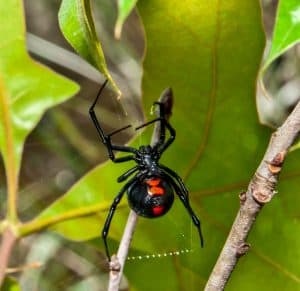
Jay Ondreicka
Spiders and Scorpions
You’ll find spiders most anywhere and everywhere but some of the worst offenders like to hang out in woodpiles, fallen trees and other places you nestle into when turkey hunting, as well as the dark, neglected corners of old buildings, ground blinds and shooting houses. Simply avoiding them is the best defense. Most spiders are relatively harmless and like wasps, don’t actively seek out humans. Still, there’s a dozen or so that are venomous, and at least three you should be aware of.
The black widow (Latrodectus sp.) can inflict a bite that’s quite painful and in rare cases potentially fatal. They produce a potent neurotoxic protein. Severity of the reaction differs with age and physical condition of the victim, with children and the elderly being particularly susceptible. Pain may be followed by severe muscle cramps, abdominal pain, weakness, and tremor, and in extreme cases, nausea, vomiting, fainting, dizziness, chest pain, and respiratory difficulty.
Though much scarier looking, the Tarantula (Theraphosidaeis sp.) is less dangerous. Their size makes them hard to miss and they often signal their intent prior to attacking by rearing up into a threat posture, extending their fangs and even making a loud hissing noise. The result of a bite is similar to that of a wasp sting.
Last, but by no means least is the brown recluse or fiddleback spider (Loxosceles reclusa). At less than an inch long, this nondescript arachnid packs quite a wallop. Initially its bite may feel like a pinprick or even go unnoticed, and most heal without scarring. However, some bites can result in intense pain and systemic reactions such as itching, fever, chills, nausea, vomiting or even shock. In severe cases, the bite causes extensive tissue necrosis (death) and a sunken ulcerating sore that may take weeks or even months to heal.
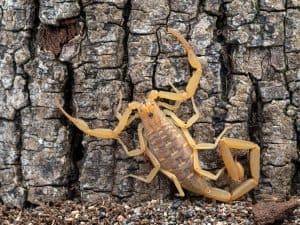
Ernie Cooper
Though they seem far more sinister, at least to me, scorpions are about as common as spiders and as dangerous as wasps. Their stings usually result in pain, minimal swelling and tenderness. One exception is the bark scorpion (Centruroides sculpturatus), which occurs in Arizona, New Mexico and the California side of the Colorado River. It has a much more toxic, painful sting that can result in more serious symptoms, especially in children.
Again, the best solution is avoidance. Stay away from preferred spider and scorpion habitat as much as you can. Check before you sit down and keep your buildings and blinds clean and tidy. Also remember that scorpions like dark, warm places. In scorpion country it’s standard practice to check your boots every morning before putting them on. Turn them over and pound on them. Don’t stick your hand in!
In all cases, if bitten, try to collect the perpetrator (even a mangled specimen) for positive identification. Remain calm and seek help. Apply an ice pack directly to the bite area to relieve swelling and pain. Consult a physician and if severe symptoms occur seek medical attention immediately.
Fire Ants

omg studio
I was vicariously introduced to fire ants on a Texas turkey hunt. With both my tags filled I decided to spend the afternoon hog hunting out of a tower blind, and asked one of my companions to snap a few photos of me looking out the window before he left. After climbing in I opened the window to a perplexing site. My friend had his pants down around his ankles and was jumping around slapping his legs. When I finally realized the situation, I could barely contain my laughter.
To someone who has had a personal encounter with fire ants it’s no laughing matter. They pack a one-two punch and find strength in numbers. First they bite, to get a grip, then sting from their abdomen to inject a toxic alkaloid venom that burns like fire – thus, the name. As they’re colonial insects, once the colony is threatened, they attack en-masse. In most cases pain is the worst part, but in rare, severe cases the stings can produce shock and even death, particularly with numerous bites.
Here again, avoidance is the best recourse. That might seem easy as most people are familiar with the large, often obvious dome-shaped nest mounds in areas of loose, dry soil. However, nests are often built under objects like timber, logs or rocks, the same places you find ticks, spiders and … snakes; so they’re best avoided.
If and when bitten, your reaction should be similar to a wasp sting. Rub the ants off briskly. If you have a slight reaction, antihistamines might help. With a severe reaction, seek medical help and maintain your composure; in other words, keep your pants on.

